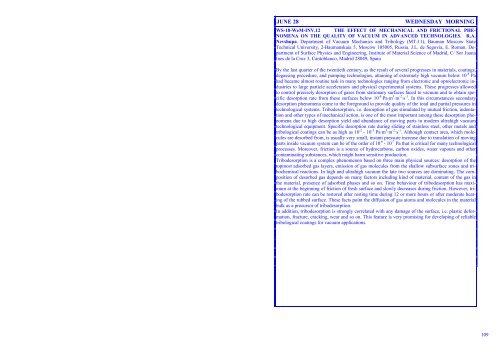Wüest M. 51 Wykes M. 82 Yamaguchi M. 17 Ybarra G. 129 Yubero F ...
Wüest M. 51 Wykes M. 82 Yamaguchi M. 17 Ybarra G. 129 Yubero F ...
Wüest M. 51 Wykes M. 82 Yamaguchi M. 17 Ybarra G. 129 Yubero F ...
You also want an ePaper? Increase the reach of your titles
YUMPU automatically turns print PDFs into web optimized ePapers that Google loves.
JUNE 28 WEDNESDAY MORNING<br />
WS-18-WeM-INV.12 THE EFFECT OF MECHANICAL AND FRICTIONAL PHE-<br />
NOMENA ON THE QUALITY OF VACUUM IN ADVANCED TECHNOLOGIES. R.A.<br />
Nevshupa. Department of Vacuum Mechanics and Tribology (MT-11), Bauman Moscow State<br />
Technical University, 2-Baumanskaia 5, Moscow 105005, Russia. J.L. de Segovia, E. Roman. Department<br />
of Surface Physics and Engineering, Institute of Material Science of Madrid, C/ Sor Juana<br />
Ines de la Cruz 3, Cantoblanco, Madrid 28049, Spain<br />
By the last quarter of the twentieth century, as the result of several progresses in materials, coatings,<br />
degassing procedure, and pumping technologies, attaining of extremely high vacuum below 10 -8 Pa<br />
had became almost routine task in many technologies ranging from electronic and optoelectronic industries<br />
to large particle accelerators and physical experimental systems. These progresses allowed<br />
to control precisely desorption of gases from stationary surfaces faced to vacuum and to obtain specific<br />
desorption rate from these surfaces below 10 -8 Pa·m 3·m -2·s -1 . In this circumstances secondary<br />
desorption phenomena come to the foreground to provide quality of the total and partial pressures in<br />
technological systems. Tribodesorption, i.e. desorption of gas stimulated by mutual friction, indentation<br />
and other types of mechanical action, is one of the most important among these desorption phenomena<br />
due to high desorption yield and abundance of moving parts in modern ultrahigh vacuum<br />
technological equipment. Specific desorption rate during sliding of stainless steel, other metals and<br />
tribological coatings can be as high as 10 -2 - 10 -3 Pa·m 3·m -2·s -1 . Although contact area, which molecules<br />
are desorbed from, is usually very small, instant pressure increase due to translation of moving<br />
parts inside vacuum system can be of the order of 10 -6 - 10 -7 Pa that is critical for many technological<br />
processes. Moreover, friction is a source of hydrocarbons, carbon oxides, water vapours and other<br />
contaminating substances, which might harm sensitive production.<br />
Tribodesorption is a complex phenomenon based on three main physical sources: desorption of the<br />
topmost adsorbed gas layers, emission of gas molecules from the shallow subsurface zones and tribochemical<br />
reactions. In high and ultrahigh vacuum the late two sources are dominating. The composition<br />
of desorbed gas depends on many factors including kind of material, content of the gas in<br />
the material, presence of adsorbed phases and so on. Time behaviour of tribodesorption has maximum<br />
at the beginning of friction of fresh surface and slowly decreases during friction. However, tribodesorption<br />
rate can be restored after resting time during 12 or more hours or after moderate heating<br />
of the rubbed surface. These facts point the diffusion of gas atoms and molecules in the material<br />
bulk as a precursor of tribodesorption.<br />
In addition, tribodesorption is strongly correlated with any damage of the surface, i.e. plastic deformation,<br />
fracture, cracking, wear and so on. This feature is very promising for developing of reliable<br />
tribological coatings for vacuum applications.<br />
109
















